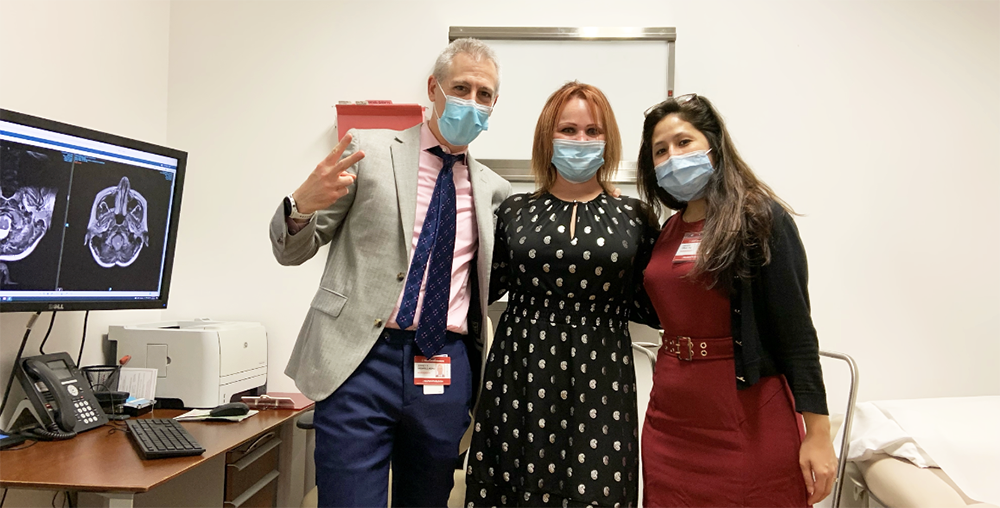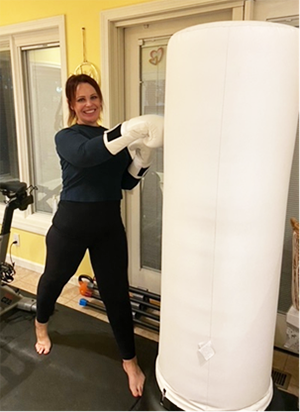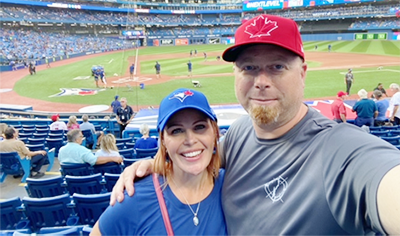
There’s nothing Marie Morris-Chaloux loves more than her family. “We spend a lot of time together,” she says. “My husband and I and our two kids travel often. We live an active life of hiking, biking, playing golf, kickboxing, or going to the gym. At home, we have our two dogs to play with along with some gardening around the house. And if I have a spare minute, I somehow practice my acoustic guitar!” These days, Marie is enjoying her life to a degree she’d never thought possible, now that Dr. Jeffrey Greenfield and his team have solved the headaches that had plagued her for decades.
Marie, who has seemingly limitless energy, has spent 20 years as a nurse in addition to being a mom, wife, and volunteer. Underneath all that energy, though, has been a constant, worsening headache and a search for answers.
“I’ve had headaches since I was a child, and my family and I searched high and low for a diagnosis,” Marie recalls. “I saw many different doctors and specialists across different disciplines, all of which came with various blood tests to look for all kinds of conditions. In my teenage years, I thought I’d had a breakthrough. A neurologist did a CT scan and told me they found Chiari malformation type I (CM-I) but told me it wasn’t severe enough to cause headaches. They told me my headaches were either from concussions, or that I was just born with it.”
“Patients shouldn’t have to create their own treatment plans."
Dr. Jeffrey Greenfield, who directs the Chiari CARE program at Weill Cornell Medicine, disagrees. “CM-I doesn’t have to be severe to cause headaches,” he says. “Chiari malformation is a structural abnormality that restricts the flow of fluid between the head and spine, which causes a range of symptoms — headaches being the most common. I believe anyone who receives a diagnosis of Chiari should be referred to a neurosurgeon, ideally one associated with a major brain and spine center that has a lot of experience with the different types of Chiari. A referral to a neurosurgeon could have saved Marie from unnecessary suffering.”
As an adult, Marie just wanted answers. “I landed in the ER multiple times for headaches,” she says. “Tests would come back normal, but I knew there was something wrong. I tried facial injections, antidepressants, blood pressure pills, and anti-seizure meds, all which left me with various side effects that compromised my quality of life — and my role as a nurse and mother. I took it upon myself to manage my pain with OTC medicines, which helped for a short time.”

Marie is back to boxing now that her Chiari has been resolved
“Patients shouldn’t have to create their own treatment plans,” says Dr. Greenfield. “When a patient comes to us, we make a recommendation based on a series of evaluations: whether the patient is in pain, if their everyday functioning is affected, or if they have a syrinx — a cyst in the spinal column. Patients in our Chiari CARE program have the benefit of a full, interdisciplinary team to ensure that they get treatment that gives them the best shot at the life they want to live.”
In 2019, Marie’s headaches worsened after a jaw procedure, and an MRI discovered a syrinx in addition to the Chiari malformation. A neurosurgeon she saw near her home in Connecticut told her she’d need decompression surgery.
“I was scared,” Marie recalls. “I was told for so many years that I wouldn’t need surgery for my Chiari, so this was all unexpected. I got a second opinion, but the second neurosurgeon said the same thing. I scheduled my surgery a month later.”
Marie underwent surgery to alleviate the pressure in her brain. “Not long after, I kept getting those familiar headaches,” she recalls. “I reached out to the neurosurgeon, who told me ‘the surgery looked successful.'”
The neurosurgeon, together with a neurologist, prescribed medications that relieved Marie’s headaches but made her feel worse overall. New kinds of debilitating pain presented itself: eye pain, head pain, neck pain, back pain, blurry vision, nausea, and vomiting, leaving her weak and tired. Marie visited a spine specialist who broke the news to her: not only couldn’t he help, but the Chiari surgery, in his opinion, had failed.
“It was time for me to look for a new neurosurgeon,” Marie says. “I found experts in New York and Boston, and I decided on Dr. Greenfield. From the first meeting, he and his PA Amanda were warm and personable while explaining everything I asked of them. I scheduled my first surgery with Dr. Greenfield for July 2021.”
“We set out to accomplish what her initial surgery hadn’t, with respect to decompressing the bone away from her brain to try and reduce the pressure in the brain,” says Dr. Greenfield. “Marie felt most comfortable with the less invasive Chiari decompression procedure, which had been done inadequately the first time. In the operating room, we drilled away specific regions of the skull base to see if we could restore CSF flow and avoid a larger procedure which is often needed to adequately address significant Chiari malformations.
After several months of recovery and honest reflection, Dr. Greenfield and Marie agreed that they had exhausted options for minimally invasive surgery, and they turned to duraplasty, a more invasive procedure that involves opening and reconstructing dura, the tissue that covers and protects the brain and spine. This usually results in a more immediate and complete reduction of pressure, but has higher risks and is usually a more difficult surgery from which to recover fully.
“Compared to the early procedures, it was the hardest to recover from,” recalls Marie. “The team took amazing care of me in the hospital. Dr. Greenfield and Amanda visited me every day and I had incredible support from my mother, husband, kids, and friends who all kept me strong when I felt so weak.”

With Chiari behind her, Marie is back in the game
“Taking care of patients who’ve already had Chiari surgery can be challenging,” says Amanda Cruz, MPA, PA-C, clinical coordinator of the Chiari CARE program. “They have to rebuild trust — not only in a new surgical team, but in the medical system as a whole. Marie embraced the news of revision surgery with open arms, thankful that she hadn’t reached the end of the road for treatment, and ready to move forward with optimism and grace. Her post-operative courses weren’t easy, but she remained optimistic throughout the journey and prevailed. I couldn’t be prouder of her progress.”
A few weeks after surgery, Marie experienced her first headache-free day without medicine. A physical therapy team helped her get stronger. And then, one year later, Marie received the all-clear from Dr. Greenfield.
“I’m stronger than I was before. I’m able to be the active, energetic mom, wife, and nurse that I want to be. I feel like my future is brighter because of the great care I received. And for anyone else going through this, you’re stronger than you think you are! Never give up, get multiple medical opinions, and you know yourself best, so trust your instincts!”
More about Dr. Greenfield | More about Chiari CARE